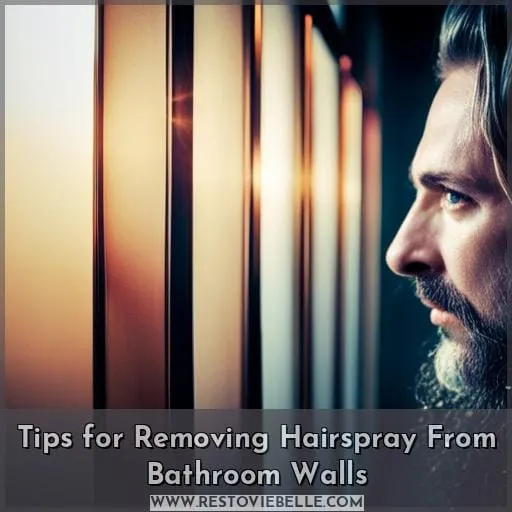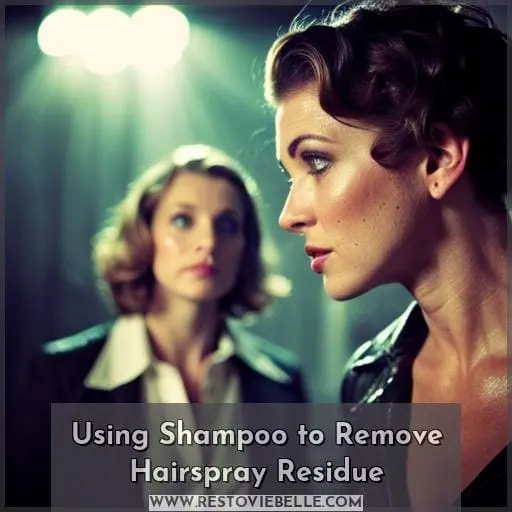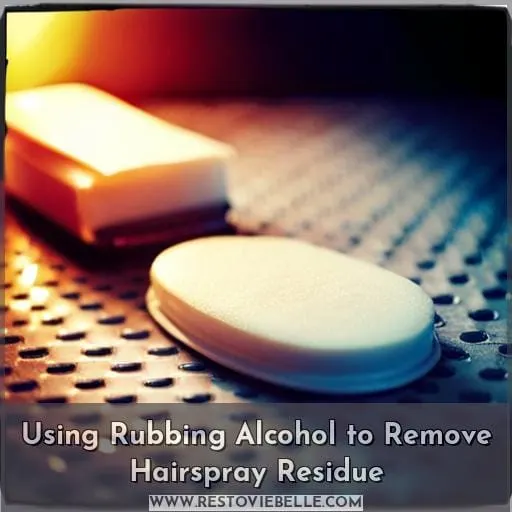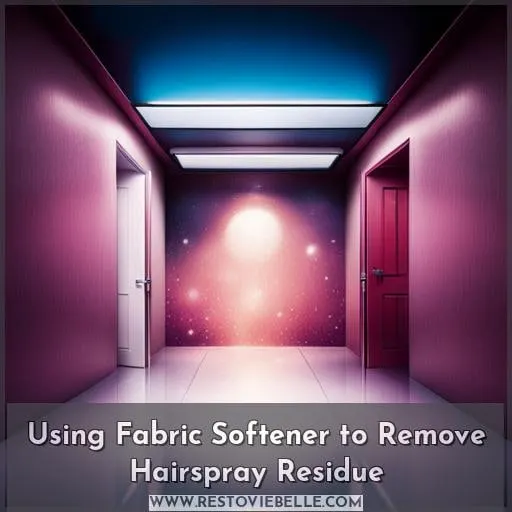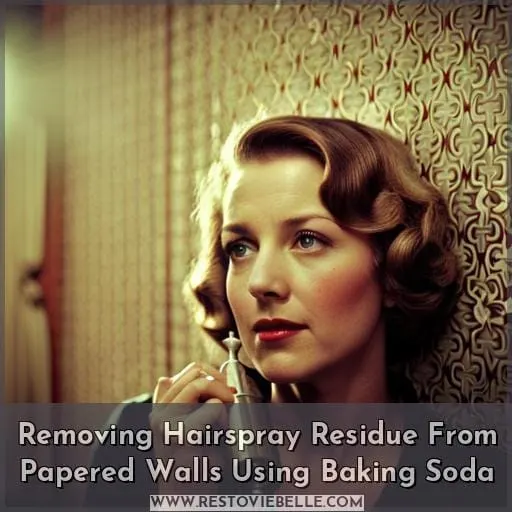This site is supported by our readers. We may earn a commission, at no cost to you, if you purchase through links.
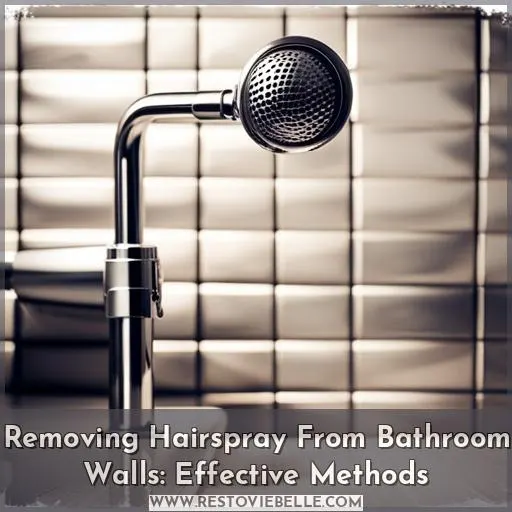 Ready to say goodbye to those stubborn hairspray stains on your bathroom walls? We’ve got you covered! In this article, we’ll show you effective methods for removing hairspray from bathroom walls. Whether it’s shampoo, rubbing alcohol, fabric softener, or baking soda that does the trick for you – we’ll guide you through each step of the process.
Ready to say goodbye to those stubborn hairspray stains on your bathroom walls? We’ve got you covered! In this article, we’ll show you effective methods for removing hairspray from bathroom walls. Whether it’s shampoo, rubbing alcohol, fabric softener, or baking soda that does the trick for you – we’ll guide you through each step of the process.
Table Of Contents
- Key Takeaways
- Tips for Removing Hairspray From Bathroom Walls
- Using Shampoo to Remove Hairspray Residue
- Using Rubbing Alcohol to Remove Hairspray Residue
- Using Fabric Softener to Remove Hairspray Residue
- Removing Hairspray Residue From Papered Walls Using Baking Soda
- Frequently Asked Questions (FAQs)
- Can I use vinegar to remove hairspray residue from bathroom walls?
- Is it safe to use a Magic Eraser on bathroom walls to remove hairspray?
- What should I do if the hairspray residue is stubborn and doesn’t come off easily?
- Can I use a hairdryer to speed up the drying process after removing hairspray residue?
- Are there any natural alternatives to commercial cleaning products for removing hairspray from bathroom walls?
- Conclusion
Key Takeaways
- Lay down protective sheets and ensure good ventilation.
- Use a shampoo and water mixture or rubbing alcohol to remove hairspray residue.
- Consider using fabric softener or baking soda for alternative cleaning methods.
- Regular maintenance and cleaning can prevent future residue buildup.
Tips for Removing Hairspray From Bathroom Walls
To effectively remove hairspray from your bathroom walls, it’s important to first prepare the area:
- Lay down protective sheets.
- Ensure good ventilation.
Next, choose the right method for your specific wall type:
- Use a shampoo-water mixture.
- Use rubbing alcohol.
By following these tips, you can successfully remove hairspray residue and keep your bathroom walls clean and fresh.
Preparing the Area
First, lay down protective sheets if needed to prevent any accidental damage or mess.
Ensure good ventilation in the bathroom by opening windows or turning on exhaust fans.
Before proceeding with removing hairspray from your bathroom walls, it’s important to take preventive measures such as covering fixtures and wearing appropriate clothing for cleaning.
Additionally, consider performing a paint touch test in an inconspicuous area to ensure that your chosen method doesn’t cause any damage or discoloration to the paint or wallpaper surface.
Choosing the Right Method
To choose the right method for removing hairspray from bathroom walls, start by considering the type of wall surface you have.
Here are some tips to help you make an informed decision:
- Evaluate the compatibility of different cleaning solutions with your wall material.
- Look for methods that effectively remove hairspray residue without causing damage.
- Consider preventive measures to minimize future residue buildup on your walls.
- Research and consult a cleaning expert or professional for guidance on effective techniques.
- Regularly maintain and clean your bathroom walls to prevent excessive accumulation of hairspray residue.
By selecting the appropriate method based on these considerations, you can effectively clean and maintain your bathroom walls free from sticky residues caused by hair products.
Using Shampoo to Remove Hairspray Residue
To effectively remove hairspray residue from your bathroom walls, you can create a mixture of 1/3 shampoo and 2/3 water in an empty spray bottle.
Apply the shampoo mixture to the affected areas and allow it to sit for a minute or two.
Then, gently scrub the surface with a sponge to remove the hairspray residue before drying it with a clean cloth for a smooth finish.
Creating a Shampoo Mixture
To effectively remove hairspray residue from bathroom walls, start by creating a shampoo mixture.
Mix equal parts of your favorite shampoo and water in a spray bottle. This combination will help break down the sticky residue left behind by hairspray.
Once you have created the mixture, simply spray it onto the affected area and let it sit for a few minutes to allow the shampoo to work its magic.
Afterward, use an abrasive sponge or cloth to gently scrub away the residue in circular motions. Be sure to choose gentle scrubbing techniques that won’t damage your wall’s paint or wallpaper.
Applying and Scrubbing
To effectively remove hairspray residue from bathroom walls, apply the shampoo mixture generously and gently scrub the surface with a sponge.
Here’s how to do it:
- Spray the shampoo mixture onto the wall.
- Use a sponge to scrub in circular motions, focusing on areas with heavy residue.
- Rinse off any excess shampoo with water and dry the surface thoroughly for optimal results.
By following these steps, you can ensure gentle cleaning that protects your surfaces while effectively removing hairspray residue from your bathroom walls.
Using Rubbing Alcohol to Remove Hairspray Residue
To remove hairspray residue from your bathroom walls, a simple and effective method is to use rubbing alcohol.
Dampen a microfiber cloth with rubbing alcohol and gently rub the walls in circular motions to eliminate the sticky residue. This technique helps break down the hairspray buildup, leaving your walls clean and free of any leftover residue.
Dampening a Microfiber Cloth
Dampen a microfiber cloth with rubbing alcohol to effectively remove hairspray residue from bathroom walls. This cleaning technique is highly efficient due to the benefits of using a microfiber cloth and the power of rubbing alcohol.
The microfiber cloth’s fine fibers trap and lift away hair product residue, while the rubbing alcohol dissolves sticky buildup.
To use this method, simply dampen the cloth with rubbing alcohol and gently rub it on the affected areas in circular motions. Follow up by wiping with a fresh, dampened microfiber cloth to ensure all residue is removed.
Gently Rubbing in Circular Motions
First, dampen a microfiber cloth with rubbing alcohol and gently rub the walls in circular motions to remove sticky hairspray residue.
This gentle cleaning method is one of the most effective methods for removing hairspray from bathroom walls. The rubbing alcohol helps break down the residue while the circular motions help lift it off the surface.
Be sure to use a fresh microfiber cloth dampened with water afterwards to remove any remaining residue and leave your walls clean and streak-free.
Using Fabric Softener to Remove Hairspray Residue
To remove hairspray residue from your bathroom walls, you can try using fabric softener.
Mix fabric softener and warm water in a spray bottle, then lightly mist the walls with the solution.
Wipe the walls from bottom to top using a damp microfiber cloth, and finish by wiping with a clean, wet cloth to remove any remaining residue.
Mixing Fabric Softener and Water
Mix fabric softener and warm water to create an effective solution for removing hairspray residue from bathroom walls.
Fabric softener application is a great alternative cleaning method that can effectively tackle sticky walls caused by hair products.
Simply mix the fabric softener with warm water in a spray bottle and lightly mist the affected areas.
Then, wipe the walls from bottom to top using a damp microfiber cloth.
Finish off by wiping with a clean, wet cloth to remove any remaining fabric softener residue.
This simple yet powerful technique will leave your bathroom walls looking clean and free of hairspray buildup.
Mist and Wipe With a Microfiber Cloth
To remove hairspray residue from bathroom walls, start by misting a mixture of fabric softener and warm water onto the affected areas. This method is effective in removing sticky residues without causing damage to the walls.
Here’s how to do it:
- Mist the fabric softener solution onto the wall.
- Use a microfiber cloth to wipe away the hairspray residue, starting from bottom to top.
- Repeat as necessary for stubborn spots.
- Finish by wiping with a clean, damp cloth to remove any remaining fabric softener residue.
The combination of misting and wiping with a microfiber cloth helps wash away hairspray buildup while leaving your bathroom walls clean and refreshed.
Removing Hairspray Residue From Papered Walls Using Baking Soda
To effectively remove hairspray residue from papered walls, you can create a baking soda paste by mixing baking soda with water.
Once the paste is ready, apply it lightly in a circular motion on the affected areas, being careful not to scrub too hard and damage the wallpaper glue.
After applying the paste, wipe it off using a damp cloth until all traces of grit are removed.
Creating a Baking Soda Paste
To create a baking soda paste for removing hairspray residue from papered walls, you’ll need to gather the necessary materials.
This baking soda technique is an effective and gentle method for stain removal without causing damage to your wallpaper.
Start by mixing baking soda with water until it forms a runny paste.
Apply the paste lightly in a circular motion, avoiding scrubbing too hard to prevent any potential damage to the delicate wallpaper glue.
After applying the paste, wipe it off with a damp cloth until there’s no remaining grit of baking soda.
This cleaning solution will help maintain your bathroom walls and keep them looking their best while ensuring proper care for your wallpaper.
Applying and Wiping With a Damp Cloth
After creating the baking soda paste, gently apply it to the papered walls in a circular motion, ensuring not to scrub too harshly. This method is effective for removing hairspray residue from papered walls without causing damage.
By applying the baking soda paste lightly and using a damp cloth to wipe away any remaining grit, you can effectively clean your bathroom walls.
Remember to choose the appropriate cleaning method based on your wall type and conduct spot tests before using abrasive substances like baking soda.
For more cleaning tips and insights from Anna, visit her website or subscribe to her exclusive newsletter for busy moms seeking easier ways of managing their homes.
Frequently Asked Questions (FAQs)
Can I use vinegar to remove hairspray residue from bathroom walls?
Yes, vinegar can effectively remove hairspray residue from bathroom walls.
Mix equal parts of vinegar and water in a spray bottle.
Spray the mixture onto the walls and wipe clean with a cloth.
Is it safe to use a Magic Eraser on bathroom walls to remove hairspray?
Yes, it’s safe to use a Magic Eraser on bathroom walls to remove hairspray residue.
Gently scrub the affected areas with the eraser, being cautious not to damage the paint finish.
What should I do if the hairspray residue is stubborn and doesn’t come off easily?
If the hairspray residue is stubborn, try using a mixture of equal parts vinegar and water.
Apply it to the affected area, let it sit for a few minutes, then scrub gently with a sponge.
Dry with a clean cloth for best results.
Can I use a hairdryer to speed up the drying process after removing hairspray residue?
Speed up the drying process after removing hairspray residue by wielding a hairdryer like a magician’s wand.
Direct its warm breath towards your clean walls, and watch as moisture evaporates, leaving behind nothing but pristine surfaces.
Are there any natural alternatives to commercial cleaning products for removing hairspray from bathroom walls?
Yes, there are natural alternatives to commercial cleaning products for removing hairspray from bathroom walls.
Try using a mixture of vinegar and water or baking soda paste.
Test on a small area first.
Conclusion
Revive your bathroom walls and say goodbye to stubborn hairspray stains with these effective methods.
Whether you choose shampoo, rubbing alcohol, fabric softener, or baking soda, you can easily remove hairspray residue and restore your walls to their clean and fresh state.
Prepare the area and choose the right method for your needs.
From creating a shampoo mixture to using rubbing alcohol or fabric softener, or even a baking soda paste for papered walls, these simple steps will help you reclaim your sparkling bathroom walls.
